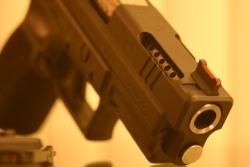Ported barrel
In firearms, the term ported relates to holes that are precision-drilled into the forward part of the barrel (and slide on pistols). These holes are designed to divert a portion of the gases expelled during firing in the direction that reduces the tendency of the firearm to flip upwards. The concept applies Newton's third law: the exhaust directed upward causes a reciprocal force downward.
Porting is most commonly used on shotguns, where recoil is most significant and makes rapid firing difficult. Even single shots of magnum-strength loads are uncomfortable for all but the most-seasoned shooters. Porting has obvious advantages for faster follow-up shots, especially for 3-round burst operation. However, in most instances porting does nothing to enhance the accuracy of follow-up shots.
[edit] Myths
One widely-propagated myth is that firing at night with a ported barrel usually decreases the shooter's night vision because the muzzle flash is redirected through the ported barrel upward into the shooter's face. This myth most likely originated with Glock's information page on compensated pistols that features three bright, intimidating flames shooting out of the top of a compensated barrel. Most people will never be able to recreate that imagery in reality unless one handloads a special batch of high-muzzle flash ammo. Most ammo branded for self-defense has relatively low to no flash compared to mass-marketed practice ammunition.
Another myth is that most law enforcement agencies prohibit their officers from carrying a weapon with a ported barrel. Each law enforcement agency has different standards with regard to duty firearms, and while some agencies prohibit compensated firearms, there are no statistics to back up this claim.
